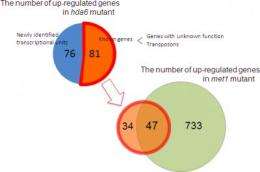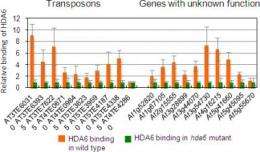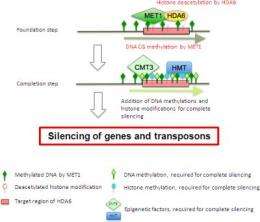Discovery of DNA silencing mechanism reveals how plants protect their genome

(PhysOrg.com) -- Researchers at the RIKEN Plant Science Center (PSC) have clarified a key epigenetic mechanism by which an enzyme in the model plant Arabidopsis protects cells from harmful DNA elements. Published in the April 28th issue of the journal PLoS Genetics, the finding contributes to advancing our understanding of a broad range of biological processes in both plants and animals, opening the door to applications in cancer therapy and agriculture.
In everything from protein synthesis to gene expression to development, living cells depend critically for their survival on the successful functioning of their DNA. Certain DNA elements such as transposons, fragments of DNA that replicate within an organism's genome, can however disrupt this functioning and disable genes. To defend against such harmful elements, eukaryotic cells form inactive tightly-packed DNA called heterochromatin, whose dense structure serves to repress (“silence”) the expression of nearby gene sequences and protect the genome.
Earlier research identified the enzyme HDA6 as playing a key role in such “hetrochromatin silencing” in the model plant Arabidopsis, but the mechanism involved remained unclear. In order to clarify this mechanism, the research group investigated the involvement of HDA6 in two processes: DNA methylation, an epigenetic modification that changes the structure of DNA without altering its sequence, and the modification of histone, the main component of chromatin.

Through a genome-wide comparison, the researchers were able to show that plants with repressed HDA6 function are not able to silence harmful DNA elements, suggesting that the enzyme plays an important role in gene silencing. Further investigation revealed that HDA6 binds directly to transposons and silences their activity through specific histone modifications, and that another enzyme, the DNA methyltransferase MET1, cooperates with HDA6 in this gene silencing.

Together, the findings establish for the first time that MET1-mediated DNA methylation and HDA6-mediated histone modification work together in repressing harmful DNA elements. By shedding light on the complex interplay between these two processes, the findings provide valuable insight on how plants and animals have evolved to protect their genome from harmful DNA, contributing to applications in areas such as cancer therapy and agriculture.
More information: To TK, Kim J-M, Matsui A, Kurihara Y, Morosawa T, et al. (2011) Arabidopsis HDA6 Regulates Locus-Directed Heterochromatin Silencing in Cooperation with MET1. PLoS Genet 7(4): e1002055. doi:10.1371/journal.pgen.1002055
Provided by ResearchSEA
















